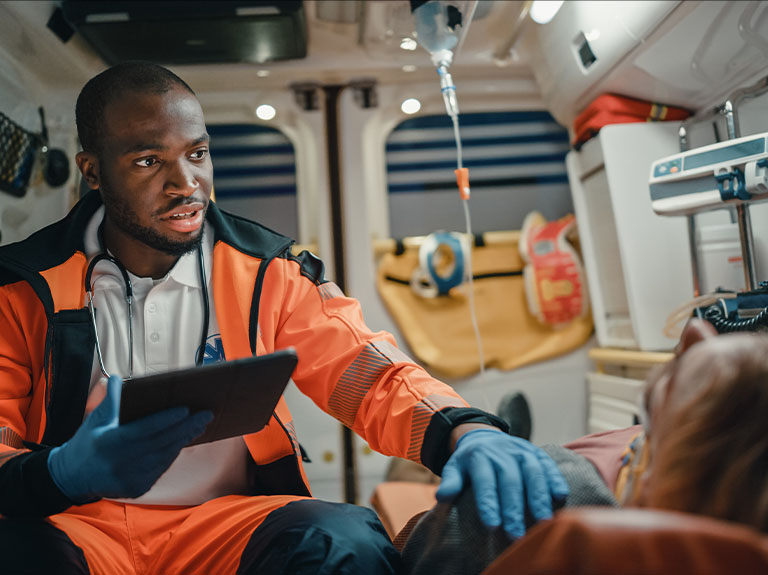The Future of Healthcare A Customer’s Perspective
Medtronic Seeks to Improve the Patient Experience With Connected Solutions
A few short weeks ago at the AT&T Business Summit, we demonstrated how connectivity is transforming healthcare. On display in the Healthcare Innovation Center was the operating room (OR) of the future.
This futuristic OR uses virtual reality (VR) to see inside the patient and navigate precisely without incisions. By integrating with artificial intelligence (AI), we can draw on data from thousands of past procedures to identify best practices and avoid potential errors during surgery. All while family members monitor the surgery remotely.
It’s amazing to see the art of the possible.
This OR may not be in practice just yet. However, technologies like VR and AI are on the rise in healthcare and other industries. And connectivity is at the core of these technologies.
Besides seeing our remarkable innovation on display, what I really loved about the Summit was meeting with our customers.
Our healthcare clients are truly innovative. They’re using technology to enhance the standard of care. And they look to AT&T, not only to provide connectivity, but as a trusted technology advisor. This lets them focus on their core competencies and improving patient outcomes.
One such customer is Medtronic, one of the world’s largest medical technology, services and solutions companies. My team helped Medtronic bring its newest Neuromodulation programming platforms to the next level.
What helps us in our role as a trusted advisor is to listen to customers like Medtronic. So I bounced a few questions about the digital transformation of healthcare off Jim Willenbring – senior marketing director for Medtronic’s RTG Digital Health & Patient Operations team – to get his perspective.
I’ve mentioned that connectivity is at the core of some innovative technologies. What benefits has connectivity brought to the Restorative Therapies Group at Medtronic?
Jim: I can tell you that moving data in multiple ways, from patients to clinicians across interconnected networks, will change the way healthcare is delivered. So, Medtronic is enhancing its traditional implant devices with digital tools that aim to enable data connectivity.
Our customers – clinicians and their patients – benefit because these new tools are designed to provide frequent objective data points that could drive more precise care and easy access to a detailed view of the patient’s therapy experience. This could help physicians and nurses have more constructive conversations with the patient about their care.
Another benefit is that reliable data connectivity allows Medtronic to deploy updates to therapy apps through high-speed networks. This keeps our applications running smoothly and opens up deploying wrap-around applications that could enhance the patient experience.
How is this changing the healthcare experience for patients?
Jim: Consumer technology is changing patients’ expectations of how they manage various aspects of their life, including their health. By developing medical device software and apps that run on mobile devices, we take that familiar, connected experience and extend that into healthcare to simplify and enhance how patients manage their day-to-day health and how they are able to interact with their healthcare providers.
Connected devices that fit into their everyday lives are critical components for this experience.
An example is our enhanced evaluation system for our sacral neuromodulation therapy. We provide patients with a consumer-driven experience during the therapy trial. Integrating consumer technology into the Medtronic therapy empowers patients to manage their disease discreetly with devices that look like a smartphone.
You’ve talked about connectivity and access to data. Can you talk about the importance of securing that data?
Jim: Data security is an extremely important aspect of connected care. We have a responsibility to ensure we’re doing our part to help protect patient data. And patients have an expectation that their healthcare data is kept secure and private.
In the future, as we enhance our digital health offerings, patients could benefit from new ways to access their information and communicate with their doctor about their health. We believe physicians could also benefit in knowing a therapy device’s connectivity is reliable and highly secure – it means they would not need to deal with troubleshooting IT issues and can focus on patient care.
I referenced earlier the OR of the Future and the art of the possible. What excites you about the future and how technology will lead to continued innovation in healthcare?
Jim: Given how healthcare is behind many other industries in its adoption of mobile, connected and data-driven technologies, I have a lot to be excited about. One of the most exciting areas is our ability to transform how patients interact with their healthcare.
If you look at the classic model of coming in to see your doctor as the primary touchpoint with the healthcare system, technology can (and already does in some places) play a major role in “erasing the clinic walls” by obtaining information from you before you come in, serving as another communication channel from your healthcare providers, and supporting the care plan that you and your doctor agree upon. In this case, technology would not be stepping in between the care from your physician, but can act like an extension or multiplier to help deliver the information you need, when you need it, and in a way that supports how you want to manage your health.
Jim and his team are doing great work to ease the pain and discomfort for so many who suffer from debilitating ailments. As we work with customers like Medtronic, I’m energized about the future of healthcare.
From the waiting room, to the operating room, to the living room, we are committed to helping healthcare organizations transform the continuum of digital health and connected care.



